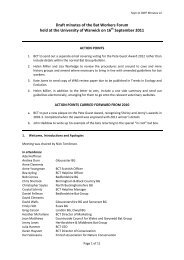Living with bats - Bat Conservation Trust
Living with bats - Bat Conservation Trust
Living with bats - Bat Conservation Trust
You also want an ePaper? Increase the reach of your titles
YUMPU automatically turns print PDFs into web optimized ePapers that Google loves.
What if I find a bat on the ground, or<br />
<strong>Bat</strong>s are shy and unobtrusive animals, so if you<br />
come across one on the ground during daylight<br />
hours or flying inside a building, it is likely to<br />
need some help. Roost owners may occasionally<br />
find <strong>bats</strong>, particularly juveniles, on the ground in<br />
their garden.<br />
<strong>Bat</strong>s should normally be handled only by<br />
licensed bat workers, but unlicensed people<br />
are allowed to handle them for the purpose<br />
of rehabilitation and release. If you find a<br />
grounded bat you may need to contact your<br />
local bat carer to help you (via the <strong>Bat</strong> Helpline).<br />
Grounded <strong>bats</strong><br />
A bat found on the ground during daylight hours<br />
is likely to be in trouble already. Sometimes, a<br />
grounded bat may just be exhausted and need a<br />
bit of time to recover <strong>with</strong> a little help. It may be<br />
injured or in danger from passing predators (such<br />
as cats), so it is better to take it into captivity<br />
temporarily and get advice from the <strong>Bat</strong> Helpline<br />
(0845 1300 228) or your local bat group.<br />
<strong>Bat</strong>s are gentle creatures and seldom show any<br />
aggression, but they are wild animals and may<br />
be frightened or in pain. You must wear<br />
protective gloves and handle the bat as little<br />
as possible.<br />
To contain a grounded bat, place a small<br />
cardboard box over the bat and use a piece of<br />
cardboard to gently and carefully slide the bat<br />
into the box. Put a loosely crumpled piece of<br />
cloth, such as an old tea towel, in one corner –<br />
the bat will feel safer if it has something to<br />
crawl into and hide. Put a few small air holes<br />
into the lid and a very shallow container of<br />
water (such as a jam jar lid) in one corner so<br />
that the bat may drink if it needs to. You can<br />
even put some wet cotton wool in the lid for the<br />
bat to drink from.<br />
Once it is dark outside you may be able to let<br />
the bat go by placing the box on its side on a<br />
wall or shed, at least five feet off the ground –<br />
don’t forget to take the lid off! The bat can then<br />
crawl out of the box and fly away when it is<br />
ready. If the bat does not fly away <strong>with</strong>in fifteen<br />
minutes, take it back inside and get expert help<br />
from your local bat carer or, if you do not know<br />
of one in your area, from the <strong>Bat</strong> Helpline.<br />
All British <strong>bats</strong> are small, and you may be<br />
surprised at how tiny they are. Juvenile <strong>bats</strong> are<br />
sometimes found on the ground in June, July or<br />
early August. At all other times of the year, they<br />
will be fully-grown and independent. Baby <strong>bats</strong><br />
have little or no fur. A good test is to blow the<br />
fur very gently – if it parts then the bat is<br />
unlikely to be very young. If you are sure it is a<br />
baby, you must get expert help as quickly as<br />
possible in order to try to locate the roost and<br />
return the baby to its mother.<br />
Daubenton’s bat, Hugh Clark




